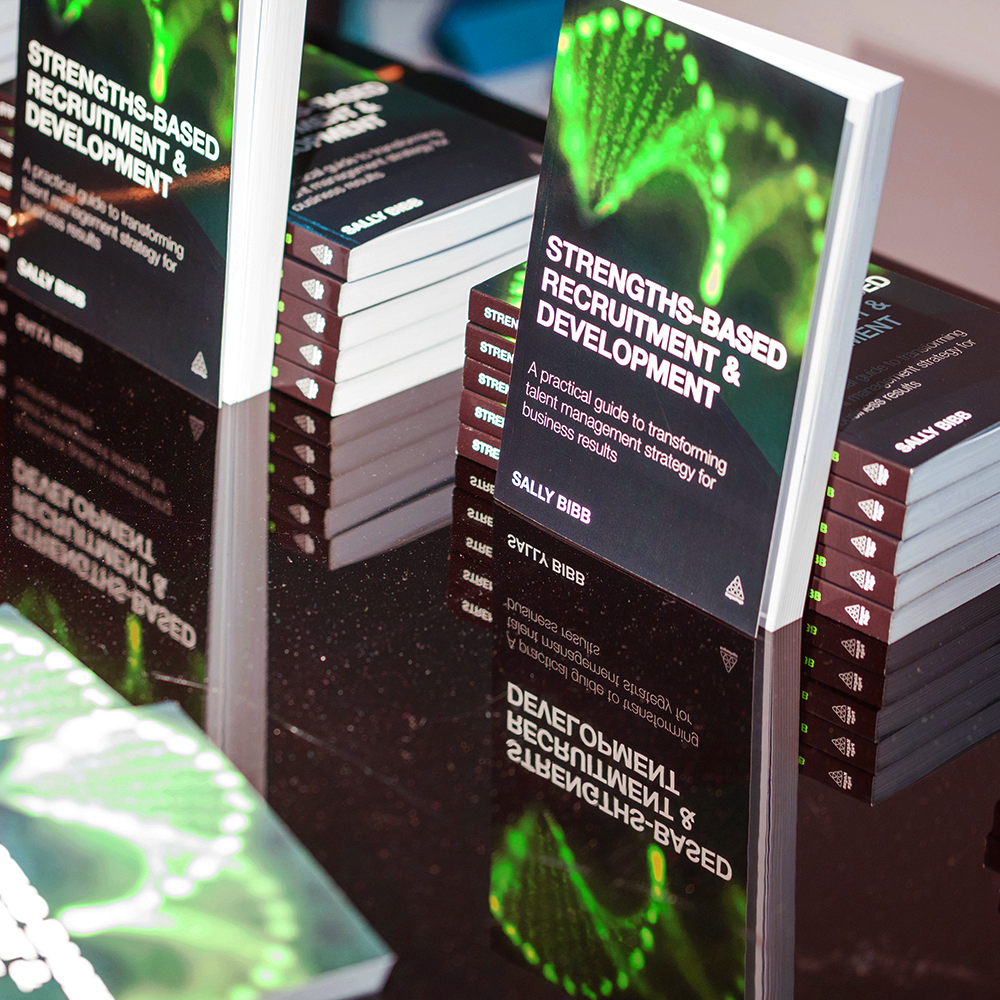
Why is interviewing young people so challenging?
Giving young people a fair chance in an interview can be extremely difficult. Because they are young, they have a limited amount of experience, so it can be hard to know what to ask them. I’ve heard recruiters say that they struggle to eke the interview out beyond five or ten minutes for that reason.
The other thing that companies struggle with when they are using a competency approach to interviewing is that answers can be Googled and practised. So, it then becomes tough to distinguish one person from another let alone see the ‘real’ person when what they are doing is trotting out rehearsed answers!
A strengths approach to interviewing young people changes all that.
Paul Dilley is a talent manager who worked with us to introduce strengths-based selection for apprentices at Lloyd’s Register.
“We wanted to be able to identify that in our potential Apprentices (traditionally school leavers or people applying for one of their first jobs), even when they don’t yet have a lot of work experience. We wanted an approach that would enable the individual’s natural passion to come through. And, we wanted a fair process that would give us concrete evidence to back up our recruitment decisions for the new Apprenticeship Programme, even when these inexperienced candidates weren’t able to give many (or any) examples of when they had displayed different competencies in a work environment.” Paul Dilley – Early Talent Manager, Lloyd’s Register
Find out what happened. Keep reading for the full interview with Paul:
Interviewing young people: a client case study
Engaging Minds worked with Lloyd’s Register in the autumn of 2016 to develop a strengths-based approach to Apprentice recruitment. We interviewed Paul Dilley six months after implementation, to find out how things are going. He told us that it’s proving to be a big success: it’s enabling them to gauge whether a young person will be a good ‘fit’ (in contrast with competency approaches, which he explained make it hard to assess young people, because of the lack of work experience they have to draw on); candidates’ experience of the new process is really positive; and managers’ feedback about the Apprentices they have recruited is “fantastic”. Paul told us about his experience of introducing SBR, the results, his advice to other organisations, and his view on the relevance of SBR to the Apprenticeship Levy.
Paul is responsible for all recruitment and selection processes for Early Talent Programmes at Lloyd’s Register: Apprenticeship, Intern, and Graduate Programmes. He commissioned Engaging Minds because he wanted to introduce a strengths-based approach to recruitment for the first intake of Apprentices at Lloyd’s Register.
How did you come to consider strengths-based recruitment (SBR)?
I’d been aware of the strengths approach to recruitment for a while, through hearing case studies at seminars and external events, specifically through the Association of Graduate Recruiters (AGR). Our recruitment processes have been quite static and traditional over the past few years, and I’ve always been open to looking at and trying innovative ways of bringing in early talent. We were introducing a new Programme for Apprentices – very early talent – and I felt it was the right time to consider a new approach for this particular Programme.
What had your experience been of recruiting young people in the past (before trying SBR)?
Our selection processes for Graduates and Interns have been competency heavy. With this, we’ve found that while many candidates may display the competencies that we are looking for, it can be very difficult to identify which candidates will be a great ‘fit’ for our us; measuring ‘fit’ can be a challenge – it’s often hard to tell whether a person is doing something because they believe in it or are passionate about it, or whether they are doing it because they perceive it is the ‘right’ thing to do. Secondly, we’ve found that however much experience a younger candidate has or however well prepared they are, there will be a limited number of examples they can give of times when they’ve demonstrated the various competencies, so they will tend to repeat themselves, talking about the same experiences at the various stages of the recruitment process; so, it can be difficult to identify anything ‘new’ about the candidates as individuals. It can be hard to feel we are getting to know them and whether they are right for us, and us for them.
What did you hope to achieve by introducing SBR for Apprentices?
For us to be successful with our Early Talent Programmes we really want to recruit people who are passionate about and believe in what they are doing. We wanted to be able to identify that in our potential Apprentices (traditionally school leavers or people applying for one of their first jobs), even when they don’t yet have a lot of work experience. We wanted an approach that would enable the individual’s natural passion to come through. And, we wanted a fair process that would give us concrete evidence to back up our recruitment decisions for the new Apprenticeship Programme, even when these inexperienced candidates weren’t able to give many (or any) examples of when they had displayed different competencies in a work environment.
For the candidates themselves, we wanted an approach that would allow them to demonstrate who they really were as individuals, and for the process to be a positive experience for them. For these people, it might be one of their very first job interviews, so we wanted them to feel relaxed and enjoy the process.
What has your experience of using SBR been?
Very, very positive! I’ll be honest and say that I was sceptical about the strengths approach to recruitment in the beginning, because I thought that it would still come down to the candidate describing examples of when they’d used a particular strength, and I couldn’t really see how that would be any different to the competency-based recruitment process. However, the Engaging Minds method means that, at interview, we are actually able to see people’s natural motivation, their enthusiasm, and their passion, when they are talking about the strengths in our Apprentice profile. So, I’ve definitely become a convert! I’m keen to roll this out for our other Early Talent Programmes and to see how a strengths approach can be applied to development too. This is definitely the way to go for us, going forward.
What has managers’ response been to using SBR?
I think the success of the approach is evidenced by the level of buy-in from our managers. They were extremely positive. If there had been any scepticism about SBR, I think the turning point was probably when we showed our managers the Apprentice strengths profile that had been created by Engaging Minds: there was a lot of nodding in the room, and very few questions – because people just ‘got it’ when they saw the profile. The response was “fantastic”, as my own manager commented to me afterwards!
Then, at the actual interviews, managers found that each candidate, while displaying the same strength, would bring something different to the table when talking about it; the interview itself became much more of a free discussion, rather than just ‘question and answer’; the conversation flowed more easily and was more relaxed, and gave a real understanding of the individual. We felt that we did get the sense of ‘fit’ that had been missing before, and that our post-assessment discussions about who to select became more efficient, based on the evidence we had gathered from the selection process.
Managers’ feedback about the new Apprentices at work is fantastic really. The work that they’re producing and their approach to work is very, very positive. I think we now need to support our managers in how to develop our strengths recruits, so that the benefits continue.
What was the experience like for the candidates themselves?
We had 100% positive feedback from the candidates about the strengths approach. The candidates hadn’t perhaps done many interviews, and so were coming in absolutely petrified, but we found that they’d come out of the interview relaxed and talkative. They loved the way it worked, saying that it felt more like a discussion than an interview. They were fully engaged with the process and able to talk freely about themselves, so that we saw the best of them.
I think too, another measure of success was how the candidates who weren’t successful responded: they fully took on board the feedback and could see for themselves why they weren’t a fit for us. It is important to us that all candidates (both successful and unsuccessful) have a positive experience and go away with a good impression of Lloyd’s Register; this approach helps with that.
How will you measure the success of this approach?
Less than six months in, we’ve already been able to see the productivity of the new intake of Apprentices, and it’s very positive, certainly higher than we’d normally expect from people of their level; we’ll definitely be measuring productivity going forward. We’ve also begun to set performance objectives for the Apprentices to encourage them to develop some of their strengths further; I think it is important not just to see the strengths-based recruitment process as ‘stand-alone’, we want to consider a strengths-based approach to development too, to continue the process. For example, accountability – that they take ownership for what they do – is one of the strengths in our Apprentice profile. So, a Performance Plan objective might be for them to take on and own a project in their environment, and deliver within six months.
Ultimately, we’ll be looking at whether and how successfully they complete their Apprentice qualification, and at retention, because going back to what I spoke of originally, if people are not a good ‘fit’ for an organisation, then eventually they may leave (the colleges we recruit from say most who do leave, usually leave within three months of joining), so that will probably be a good measure for us too; we’re now five months in with the first intake and all our Apprentices are still with us, so that’s a good sign.
Longer term, how other parts of the organisation view what we’ve done will reflect how successful the approach has been; we’d like to be seen as the centre of expertise for innovative initiatives such as the strengths approach.
What advice could you give to others who might be considering adopting a strengths-based approach to recruitment for young people?
Well, given the success we’d had, I could just say, “Absolutely, do it!” But, I think, being pragmatic, you have to assess whether it is right for your particular set of circumstances. I think the success of the approach in any organisation will depend on the level of buy-in from your key stakeholders and managers. It needs to feel like a collaborative approach, not just something that any one person thinks is a good idea or that market forces suggest is a good idea. With any new approach, managers might see it as ‘just another HR initiative’ so it’s essential to engage them and involve them with open and honest communication all the way, including with the Engaging Minds team, so that they fully understand and believe in the approach. We went through mock interviews with our managers where we showed them how the strengths-based interview would work in practice; they could see the links back to the strengths profile, to their team, to the organisational culture, to the high-level strategy. For success, the initiative needs to feel cohesive and collaborative, and owned by the whole management team.
Why did you choose to work with Engaging Minds, and what feedback would you give about their methodology?
When I sat down with Sally Bibb, I felt she was listening to me and what we needed in our organisation. It seemed to me she knew where I was coming from. Sally’s passion for what she does is incredible, and the team were fantastically flexible. But, basically what they did was thoughtfully created for us and shaped around us, to our budget and within our timescale, which was short! I walked away from my first meeting with Sally, enthused.
A topical question…
What are your thoughts regarding the Apprenticeship Levy and what (if any) relevance SBR may have to it?
Organisations that haven’t traditionally offered apprenticeships will now be looking much more closely at the benefits of introducing these programmes. This could mean that there will be reflection about whether existing recruitment approaches will be suitable for these ‘very early talent’ programmes or not. Thus, it could mean a rise in interest in strengths-based recruitment, in order to offer young people (who don’t have a lot of work experience, as I’ve mentioned) a fairer recruitment process, based on their strengths rather than their competencies. On the other hand, not everyone is using the Apprenticeship Levy to bring in early level talent, because with this legislation an ‘apprenticeship’ can apply to anyone; organisations might be using it to re-skill and re-train existing staff, too.
How has it been to talk about this with us?
It’s been good to talk it over and revisit it after six or seven months, and realise the success of it. So, thank you!
Thank you to Paul Dilley of Lloyd’s Register for sharing his experience with us.
Sally Bibb’s book Strengths-based Recruitment and Development: A Practical Guide to Transforming Talent Management Strategy for Business Results (the first on the subject) is published by Kogan Page.


